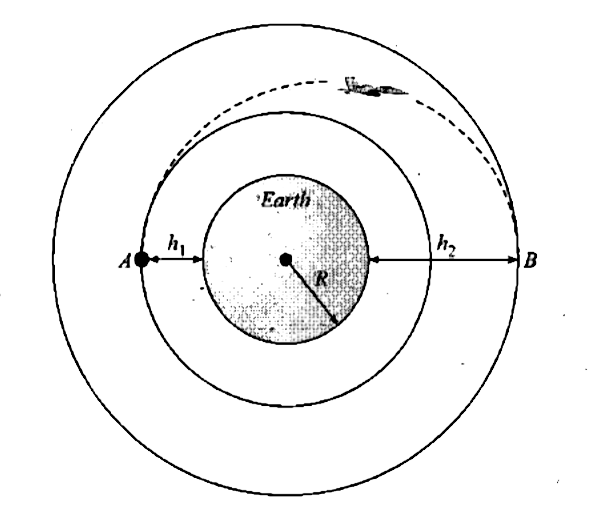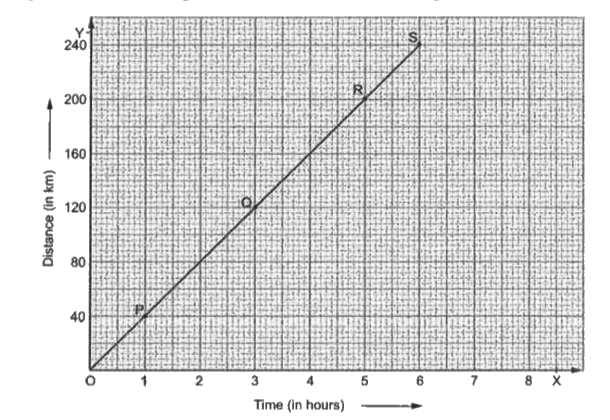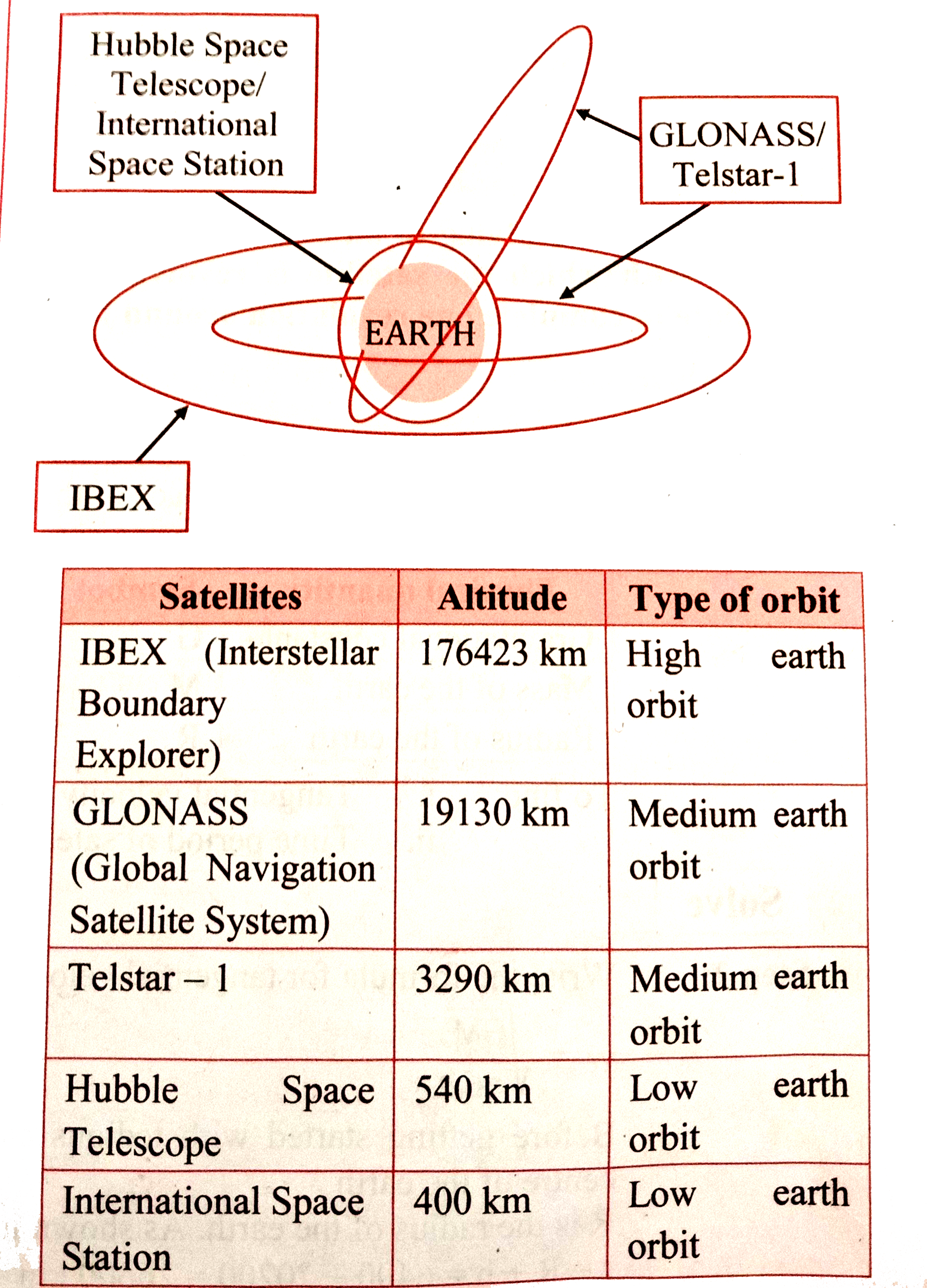Arrange the satellites mentioned below in their repective orbits in the given figure.
(i) IBEX (Interstellar Boundary Explorer) [Altitude ≈ 176423 km]
(ii) International Space station [Altitude ≈ 400km]
(iii) GLONASS
(Global Navigation Satellite System)[Altitude≈ 19130km]
(iv) Hubble Space Telescope [Altitude≈ 540km]
(v) Telstar =1 [Altitude ≈ 3290 km]
![Arrange the satellites mentioned below in their repective orbits in the given figure. (i) IBEX (Interstellar Boundary Explorer) [Altitude ~~ 176423 km] (ii) International Space station [Altitude ~~ 400km] (iii) GLONASS (Global Navigation Satellite System)[Altitude~~ 19130km] (iv) Hubble Space Telescope [Altitude~~ 540km] (v) Telstar =1 [Altitude ~~ 3290 km]](https://d10lpgp6xz60nq.cloudfront.net/physics_images/TRG_SCI_TECH_X_P1_C10_E12_006_Q01.png)
Topper's Solved these Questions
- SPACE MISSIONSBOOK - TARGET PUBLICATIONCHAPTER - SPACE MISSIONSEXERCISE - Practice Problems
4 Videos
- SPACE MISSIONSBOOK - TARGET PUBLICATIONCHAPTER - SPACE MISSIONSEXERCISE - Apply your Knowledge
2 Videos
- SPACE MISSIONSBOOK - TARGET PUBLICATIONCHAPTER - SPACE MISSIONSEXERCISE - Complete the given Chart/table
1 Videos
- SOCIAL HEALTH BOOK - TARGET PUBLICATIONCHAPTER - SOCIAL HEALTH EXERCISE - CHAPTER ASSESSMENT
3 Videos
- TOWARDS GREEN ENERGY BOOK - TARGET PUBLICATIONCHAPTER - TOWARDS GREEN ENERGY EXERCISE - Chapter Assessment
2 Videos
Similar Questions
Two Earth satellites, A and B, each of mass m, are to be launched into circular orbits about Earth's center. Satellite A is to orbit at an altitude of 6370 km. Satellite B is to orbit at an altitude of 19 850 km. The radius of Earth R, is 6370 km. (a) What is the ratio of the potential energy of satellite B tu trial of satellite A, in orbit? (b) What is the ratio of the kinetic energy of satellite R to that of satellite A, in orbit? (C) Which satellite has the greater total energy if each has a mass of 14.6 kg? (d) By how much?
View SolutionTaking the earth to be a uniform sphere of radius 6400km and the value of g at the surface to be 10ms−2, calculate the energy needed to raise a satellite of mass 2000kg to a height of 800km a above the earth's surface and to set it into circular orbit at that altitude.
View Solution
Knowledge Check
The international space station is maintained in a nearly circular orbit with a mean altitude of 330 km and a maximum of 410 km. An astronaut is floating in the space station's cabin. The acceleration of astronaut as measured from the earth is -
AZeroBnearly zero and directed towards the earthCnearly g and directed along the line of travel of the stationDnearly g and directed towards the earthA man standing on an international space sattion, which is orbiting earth at an altitude 520km with a constant speed 7.6km/s. If the man's weight is 50kg, this acceleration is (radius of earth is 6400km and value of g on earth is 9.8m/s2).
A4.6ms−2B7.6ms−2C8.4ms−2D10ms−2for a satellite to be geostationary, which of the following are essential conditions?
(i) It must always be stationed above the equator.
(ii) It must rotates from west to east.
(iii) It must be about 36,000km above the earth
(iv) Its orbit must be circular and not elliptical.A(i),(ii)B(ii),(iii)C(i),(ii),(iv)DAll
The International Space Stations (ISS), a habitable artificial satellite, is orbiting around earth at an altitude of 400 km. Calculate the additional velocity required to be given to escape the ISS from gravitational pull of earth.
View SolutionThe optimal way of transferring a space vehicle from an inner circular orbit to an outer coplanar circular orbit is to fire its engines as it passes through A to increase its speed and place it in an elliptic transfer orbit. Another increase in speed as it passes through B will place it in the desired circular orbit. For a vehicle in a circular orbit about the earth at an altitude h1=320km, which is to be transferred to a circular orbit at an altitude h2=800km, determine :
(a) The required increases in speed at A and B.
(b) The total energy per unit mass required to execute the

View SolutionThe telescopes on some commercial surveillance satellites can resolve objects on the ground as small as 85 cm across (see Google Earth), and the telescopes on military surveillance satellites reportedly can resolve objects as small as 10 cm across. Assume first that object resolution is determined entirely by Rayleigh's criterion and is not degraded by turbulence in the atmosphere. Also assume that the satellites are at a typical altitude of 420 km and that the wavelength of visible light is 550 nm. What would be the required diameter of the telescope aperture for (a) 85 cm resolution and (b) 10 cm resolution? (c) Now, considering that turbulence is certain to degrade resolution and that the aperture diameter of the Hubble Space Telescope is 2.4 m, what can you say about the answer to (b) and about how the military surveillance resolutions are accomplished?
View SolutionThe following distance-time graph is for a car travelling to certain places.

Study the above distance-time graph carefully and answer the questions given below :
(i) How far does the car travel in 412 hours ?
(ii) Hou much time does the car take to reach R ?
(iii) How long does the car take to cover 80km?
(iv) How far is Q from the starting point ?
(v) When does the car reach the place S after starting ?
View SolutionA satellite is in a circular polar orbit of altitude 300km. Determine the sparation d at the equator between the ground tracks associated with two successive overhead passes of the satellite.
View Solution

